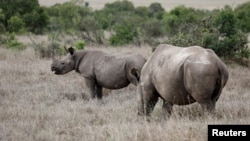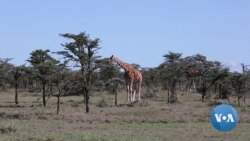A wildlife conservancy in Kenya is trying out a new use for technology to protect its four-legged inhabitants. It is applying cattle tracking technology to monitor rhinos, one of the world’s most endangered species.
The 36,000-hectare Ol Pejeta Wildlife Conservancy is a sanctuary for endangered white and black rhinos. The animals roam freely, oblivious to the dangers that face them, especially from poachers.
The conservancy in central Kenya is using cattle tracking video technology provided by a local business in hopes of saving rhinos and other wildlife. Data is analyzed inside a technology lab at the conservancy, said William Njoroge, the head of technology at the conservancy.
“Traditionally we have monitored those corridors by checking for footprints and estimating how many animals of certain species have moved either in or out,” he said. “With the technology of the cameras we can tell with certainty that specific animals have moved in or out because they can be counted.”
Ben Roberts of Liquid Telecom, the firm that helped set up the facility, says the technology also helps protect all animals from predators.
“They lose about 60 cattle a year to the lions, so if you can track the positions of lions, if you can track the position of cows, then you can start to predict and help the farmers to make sure they lose less and they can move their cattle away when the lions are hunting. These are the sort of things that can make a difference,” he said.
The conservancy spends at least $10,000 every year to protect animals from poachers. It hopes the new technology will help bring down the cost and help Kenya solidify its position as a top destination for wildlife tourism, said Samuel Mutisya, the head of Conservation at Ol Pejeta.
“It helps in making decisions and linking different sensors in one platform to make a sober decision either to prevent conflict to look at resource utilization and how they are being utilized in space,” he said.
In the last 10 years, Kenya, like many sub-Saharan African countries, has battled poachers who kill rhinos for their horns. There is high demand for the horns in Asia, because of unproven beliefs the horns have healing properties.













